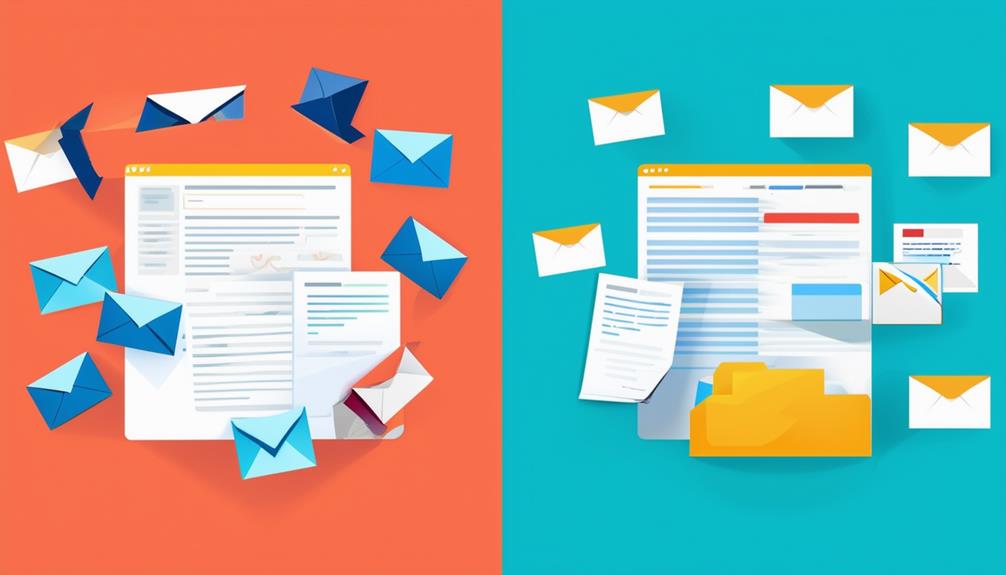
As you delve into the world of cold email outreach, you’re likely wondering what sets apart the most successful campaigns from those that fall flat. It’s not just about sending out a mass email blast, but rather crafting a tailored approach that resonates with your target audience. You’re about to discover the strategies that top performers use to drive conversions and scale their businesses through cold email. But first, let’s get one thing straight: it’s not just about the number of emails you send, but how you send them. Are you ready to reveal the secrets of cold email mastery?
Step-by-step guide to starting a cold email campaign
Step 1: Define Your Goals
- Objective: Determine what you want to achieve with your cold email campaign. Common goals include lead generation, appointment setting, or promoting a product/service.
- Metrics: Identify key performance indicators (KPIs) such as open rates, response rates, and conversion rates.
Step 2: Build Your Ideal Client Profile (ICP)
- Company Level: Consider location, company size, estimated revenue, industry, keywords, technologies used, funding history, and job postings.
- People Level: Focus on job titles and years of experience.
- Research: Use tools like Apollo to analyze your top clients and identify common characteristics.
Step 3: Choose Your Lead Scraping Tools
- Primary Tools: Apollo, Outscraper, and natural congregations (e.g., LinkedIn, Facebook groups).
- Secondary Tools: ListKit, Sales Navigator, Seamless.ai, Store Leads, Crunchbase, IG Leads.
Step 4: Verify, Format, and Enrich Your Leads
- Verification: Use MillionVerifier to ensure email validity.
- Catchall Validation: Use tools like Scrubby to validate catchall emails.
- Formatting: Clean up company names and fill in missing locations.
- Enrichment: Use BetterContacts to enrich your lead list with missing data.
Step 5: Set Up Your Technical Infrastructure
- Domains: Purchase burner domains from GoDaddy or Porkbun.
- Email Providers: Use Outlook via Microsoft 365 for creating users.
- Configuration: Set up SPF, DKIM, and DMARC records. Add custom tracking domains and ensure privacy protection is turned off.
- Warm-Up: Use tools like Instantly or SmartLead to warm up your inboxes for at least 14 days.
Step 6: Write Your Cold Emails
- Cold-Friendly Offer: Create a compelling offer with a specific avatar, specific outcome, and risk reversal.
- Subject Lines: Use curiosity-driven subject lines like Quick question or Thoughts?.
- Email Structure: Follow a simple framework:
- Opener: Relevant and personalized first line.
- Body: Present your cold-friendly offer.
- Call to Action (CTA): Low-risk, easy-to-answer question.
- Signature: Professional signature with contact details and social proof.
- Spin Tax: Use spin tax to randomize words and sentences to avoid spam filters.
Step 7: Create Follow-Up Sequences
- Sequence: Plan for an initial email plus 4-5 follow-up emails.
- Relevance: Ensure follow-ups are relevant to the initial email.
- Call to Actions: Include CTAs in follow-ups to maximize response rates.
Step 8: Manage Your Inbox
- Speed to Lead: Respond to leads within 15 minutes.
- Personalization: Manually send personalized responses.
- Follow-Up: Use subsequences for positive replies and out-of-office responses.
- Outbound Dials: Call leads who respond positively to maximize meetings booked.
Step 9: Monitor and Optimize Deliverability
- Open Tracking: Turn off open tracking after initial testing.
- Email Limits: Maintain a 1:1 ratio of cold emails to warm-up emails, with a total limit of 60 emails per day.
- Ramp-Up: Gradually increase sending volume.
- Health Checks: Use tools like InboxAlly to monitor inbox health.
Step 10: Stay Updated
- Resources: Follow industry experts on Twitter, join Facebook groups, and subscribe to relevant YouTube channels.
- Continuous Learning: Stay informed about changes in cold email best practices and tools.
This guide is a summary of the information provided in a free 3-hour training you can watch below:
Starting a cold email campaign involves careful planning, precise execution, and continuous optimization. By following these steps, you can create a successful cold email campaign that generates leads and drives business growth.
Cold Email Vs. Paid Ads Strategy
When it comes to client acquisition, you have two powerful strategies at your disposal: cold email and paid ads, both of which are essential for a well-rounded approach.
To decide which strategy to use, it’s important to weigh the pros and cons of each. Cold email offers low costs and high scalability, making it ideal for large volumes of outreach. However, it requires a personal touch and can be time-consuming.
Paid ads, on the other hand, provide rapid results and targeting capabilities, but can be costly and competitive. Comparing their effectiveness, cold email excels in niches with publicly advertised contact info, while paid ads shine with a daily budget of at least $30.
Scaling Business With Cold Email
To scale your business beyond $100,000 per month, you need to build a cold email infrastructure that can handle massive volumes of outreach, allowing you to target and engage with a large number of potential clients.
This requires implementing cold email automation to streamline your outreach process and increase efficiency. Effective client acquisition techniques, such as personalization and segmentation, are essential to maximize conversions.
| Cold Email Automation | Client Acquisition Techniques | Benefits |
|---|---|---|
| Personalization | Targeted outreach | Increased conversions |
| Segmentation | Customized messaging | Better engagement |
| Scheduling | Timely follow-ups | Improved efficiency |
Cold Email Success Stories
By examining the strategies of successful entrepreneurs who’ve leveraged cold email to drive business growth, you can glean valuable insights to inform and optimize your own outreach efforts.
Industry influencers like Cole Gordon, Tanner Chidester, and Alex Rossi have achieved remarkable success through cold email, demonstrating its potential for business growth.
Case studies of these successful entrepreneurs provide actionable lessons on how to build and scale a cold email infrastructure. You can learn how they validated their offers, refined their marketing strategies, and scaled their client onboarding through cold email.
Technical Setup for Deliverability
Now that you’ve learned from the successes of Cole Gordon, Tanner Chidester, and Alex Rossi, it’s time to get hands-on and set up your cold email infrastructure for best deliverability.
You’ll need a solid technical setup to guarantee your emails land in inboxes, not spam folders. Here are the essential steps to get started:
- Choose a domain: Select a reputable registrar like GoDaddy or Porkbun, and opt for a `.io` domain for better deliverability.
- Set up email automation: Use a reliable email provider that allows automation, and create users under your domain for improved deliverability.
- Structure your domain name: Use a clear and concise naming convention to avoid flagging as spam.
- Avoid third-party email hosts: Keep your email infrastructure in-house to maintain control and ensure superior deliverability.
Optimizing Email Providers
You’ll greatly enhance your cold email campaigns by selecting an ideal email provider that allows seamless automation, scalability, and superior deliverability. When comparing email providers, consider factors like deliverability metrics, scalability, and automation capabilities.
Microsoft 365’s Outlook is a top choice, offering good deliverability and minimal restrictions. GoDaddy, on the other hand, offers discounts on domain purchases and email essentials. Avoid third-party email hosts, as they can hinder deliverability.
Opt for a provider that allows easy user creation and domain structuring for best deliverability. By choosing the right email provider, you’ll experience improved campaign performance and increased ROI. Make an informed decision by weighing the benefits and drawbacks of each provider, and watch your cold email campaigns thrive.
Frequently Asked Questions
How Do I Personalize Cold Emails Without Being Overly Time-Consuming?
“You efficiently personalize cold emails by leveraging email segmentation and personalization tools, allowing you to tailor messages without sacrificing time, making your outreach more effective and increasing the likelihood of responses.”
What’s the Ideal Cold Email Sequence for New Business Leads?
You’ll want to craft a 4-6 email sequence, spaced 3-4 days apart, focusing on lead nurturing and education, with decreasing frequency to avoid overwhelming new leads, and increasing personalized touches to build trust and credibility.
Can I Use Cold Email for B2C Marketing, or Is It Only for B2b?
You can definitely use cold email for B2C marketing, focusing on consumer targeting and ensuring email inclusivity, as it allows you to personalize and connect with individual customers on a deeper level.
How Often Should I Rotate or Update My Cold Email Templates?
To avoid Template Fatigue, you’ll want to rotate or update your cold email templates every 2-3 months to maintain Content Freshness and keep your outreach engaging, ensuring your message stays relevant and effective.
Are There Any Cold Email Laws or Regulations I Should Be Aware Of?
As you craft your cold email strategy, remember to comply with data protection regulations like GDPR and CAN-SPAM, ensuring you’re obtaining necessary consents and honoring opt-outs to avoid legal repercussions.
Conclusion
You’ve mastered the art of cold email outreach! By balancing personalization, automation, and strategic planning, you’ve cracked the code to scaling your business.
With a solid understanding of your target audience, compelling messaging, and clever segmentation, you’re poised for success.
Continuously refine your strategy based on data and feedback to optimize conversions.
Now, take your business to the next level by implementing automation tools and leveraging cold email campaigns to drive growth.
- Google Business Profile Optimization Tips - 15/09/2025
- 7 Proven Strategies to Attract More Local Customers - 09/09/2025
- What Is Local SEO and Why Does It Matter? - 08/09/2025


